Unit 1 The Amazon Rainforest_ A Natural Treasure Reading课件
文档属性
| 名称 | Unit 1 The Amazon Rainforest_ A Natural Treasure Reading课件 |  | |
| 格式 | pptx | ||
| 文件大小 | 130.1MB | ||
| 资源类型 | 试卷 | ||
| 版本资源 | 牛津译林版(2019) | ||
| 科目 | 英语 | ||
| 更新时间 | 2025-07-31 16:35:54 | ||
图片预览

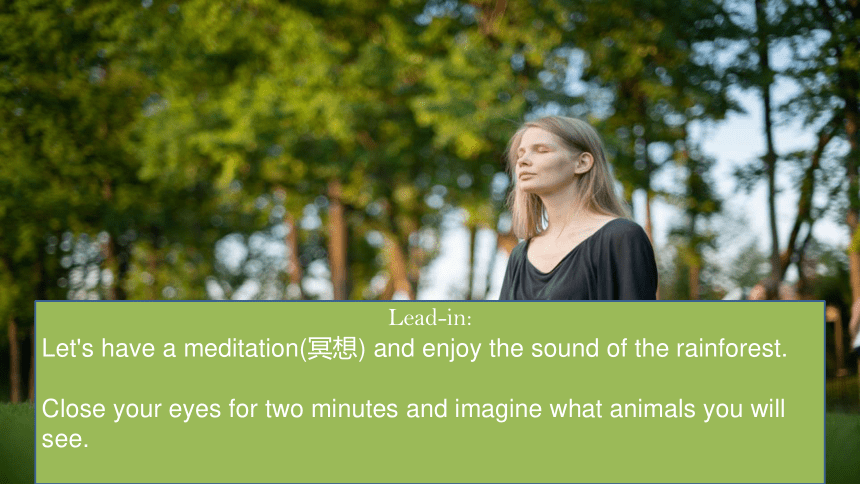
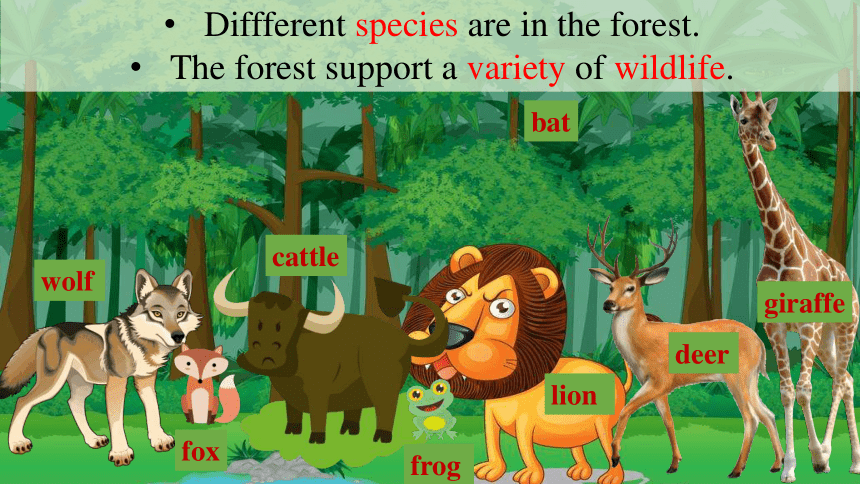
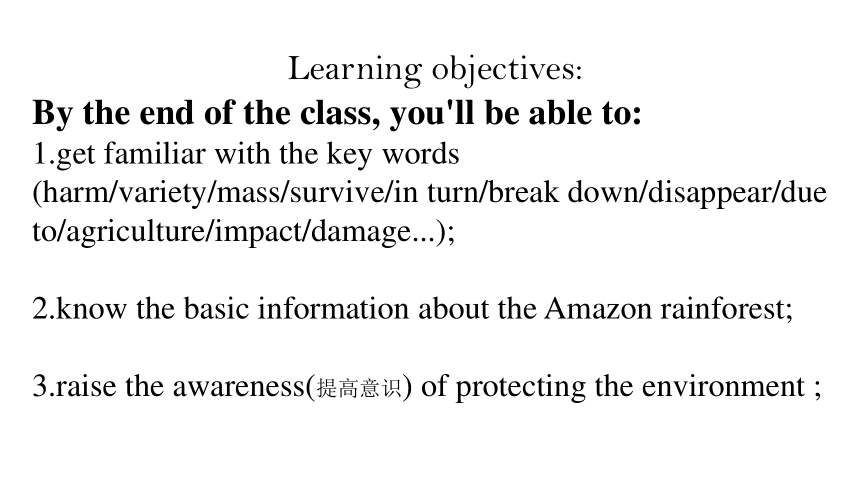
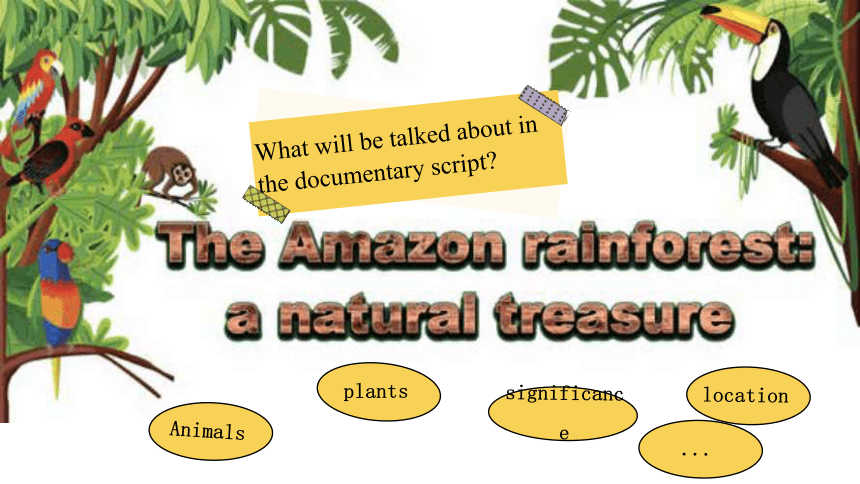
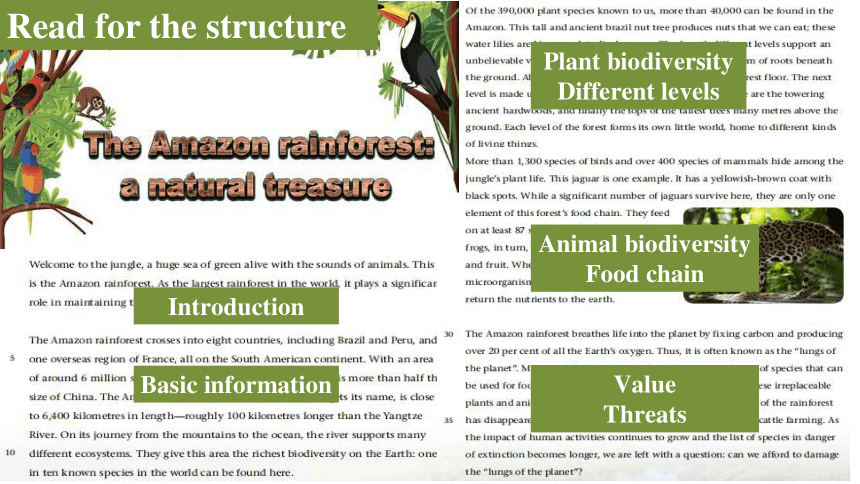
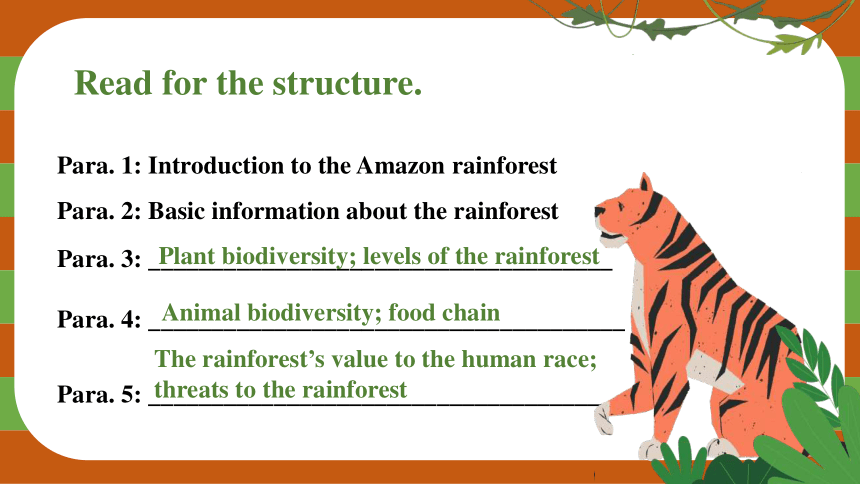
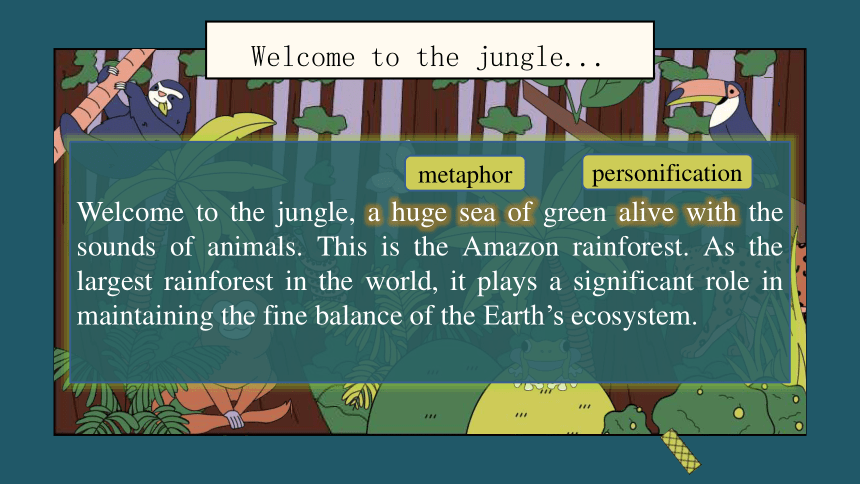
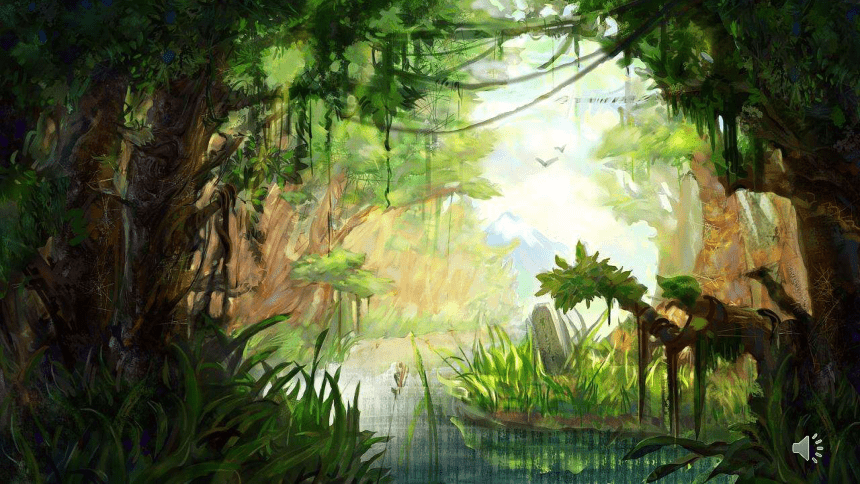
文档简介
(共21张PPT)
B3U1 Reading
The Amazon rainforest:
a natural treasure
Lead-in:
Let's have a meditation(冥想) and enjoy the sound of the rainforest.
Close your eyes for two minutes and imagine what animals you will see.
wolf
fox
cattle
frog
lion
deer
giraffe
bat
Diffferent species are in the forest.
The forest support a variety of wildlife.
Learning objectives:
By the end of the class, you'll be able to:
1.get familiar with the key words (harm/variety/mass/survive/in turn/break down/disappear/due to/agriculture/impact/damage...);
2.know the basic information about the Amazon rainforest;
3.raise the awareness(提高意识) of protecting the environment ;
What will be talked about in the documentary script
Animals
plants
significance
location
...
Plant biodiversity
Different levels
Value
Threats
Animal biodiversity
Food chain
Introduction
Basic information
Read for the structure
Para. 1: Introduction to the Amazon rainforest
Para. 2: Basic information about the rainforest
Para. 3: _____________________________________
Para. 4: ______________________________________
Para. 5: ______________________________________
Read for the structure.
Plant biodiversity; levels of the rainforest
Animal biodiversity; food chain
The rainforest’s value to the human race; threats to the rainforest
Welcome to the jungle, a huge sea of green alive with the sounds of animals. This is the Amazon rainforest. As the largest rainforest in the world, it plays a significant role in maintaining the fine balance of the Earth’s ecosystem.
Welcome to the jungle...
metaphor
personification
The Amazon rainforest crosses into eight countries, including Brazil and Peru, and one overseas region of France, all on the South American continent. With an area of around 6 million square kilometres, the Amazon rainforest is more than half the size of China. The Amazon River, from which the rainforest gets its name, is close to 6,400 kilometres in length—roughly 100 kilometres longer than the Yangtze River. On its journey from the mountains to the ocean, the river supports many different ecosystems. They give this area the richest biodiversity on the Earth: one in ten known species in the world can be found here.
location
size
origin
make comparison
Para. 3 Draw a mind map of the rainforest’s different levels.
a system of roots
Levels of the Rainforest
the mass of leaf litter
shorter plants with large leaves
the tops of the
tallest trees
towering ancient hardwoods
The forest’s different levels support an unbelievable variety of wildlife.
Para. 4 Draw a mind map of the rainforest’s food chain.
Jaguars
Insects
At least 87 species, including frogs
Leaves and fruit
Microorganisms
feed on
break down
feed on
feed on
The Amazon rainforest breathes life into the planet by fixing carbon and producing over 20 per cent of all the Earth’s oxygen. Thus, it is often known as the “lungs of the planet”. Moreover, the Amazon rainforest is a treasure house of species that can be used for food or medicine. Yet there is one major danger to these irreplaceable plants and animals: us. Over the past 50 years, about 17 per cent of the rainforest has disappeared due to human activities such as agriculture and cattle farming. As the impact of human activities continues to grow and the list of species in danger of extinction becomes longer, we are left with a question: can we afford to damage the “lungs of the planet”
What makes the Amazon Rainforest a natural treature
HABITAT LOSS
DEFORESTATION
40,000
8
1,300
400
20%
17%
6 million
6,400
use statistics
Should we sacrifice(牺牲) the rainforest for economic development
Mini-debate
Thank you!
B3U1 Reading
The Amazon rainforest:
a natural treasure
Lead-in:
Let's have a meditation(冥想) and enjoy the sound of the rainforest.
Close your eyes for two minutes and imagine what animals you will see.
wolf
fox
cattle
frog
lion
deer
giraffe
bat
Diffferent species are in the forest.
The forest support a variety of wildlife.
Learning objectives:
By the end of the class, you'll be able to:
1.get familiar with the key words (harm/variety/mass/survive/in turn/break down/disappear/due to/agriculture/impact/damage...);
2.know the basic information about the Amazon rainforest;
3.raise the awareness(提高意识) of protecting the environment ;
What will be talked about in the documentary script
Animals
plants
significance
location
...
Plant biodiversity
Different levels
Value
Threats
Animal biodiversity
Food chain
Introduction
Basic information
Read for the structure
Para. 1: Introduction to the Amazon rainforest
Para. 2: Basic information about the rainforest
Para. 3: _____________________________________
Para. 4: ______________________________________
Para. 5: ______________________________________
Read for the structure.
Plant biodiversity; levels of the rainforest
Animal biodiversity; food chain
The rainforest’s value to the human race; threats to the rainforest
Welcome to the jungle, a huge sea of green alive with the sounds of animals. This is the Amazon rainforest. As the largest rainforest in the world, it plays a significant role in maintaining the fine balance of the Earth’s ecosystem.
Welcome to the jungle...
metaphor
personification
The Amazon rainforest crosses into eight countries, including Brazil and Peru, and one overseas region of France, all on the South American continent. With an area of around 6 million square kilometres, the Amazon rainforest is more than half the size of China. The Amazon River, from which the rainforest gets its name, is close to 6,400 kilometres in length—roughly 100 kilometres longer than the Yangtze River. On its journey from the mountains to the ocean, the river supports many different ecosystems. They give this area the richest biodiversity on the Earth: one in ten known species in the world can be found here.
location
size
origin
make comparison
Para. 3 Draw a mind map of the rainforest’s different levels.
a system of roots
Levels of the Rainforest
the mass of leaf litter
shorter plants with large leaves
the tops of the
tallest trees
towering ancient hardwoods
The forest’s different levels support an unbelievable variety of wildlife.
Para. 4 Draw a mind map of the rainforest’s food chain.
Jaguars
Insects
At least 87 species, including frogs
Leaves and fruit
Microorganisms
feed on
break down
feed on
feed on
The Amazon rainforest breathes life into the planet by fixing carbon and producing over 20 per cent of all the Earth’s oxygen. Thus, it is often known as the “lungs of the planet”. Moreover, the Amazon rainforest is a treasure house of species that can be used for food or medicine. Yet there is one major danger to these irreplaceable plants and animals: us. Over the past 50 years, about 17 per cent of the rainforest has disappeared due to human activities such as agriculture and cattle farming. As the impact of human activities continues to grow and the list of species in danger of extinction becomes longer, we are left with a question: can we afford to damage the “lungs of the planet”
What makes the Amazon Rainforest a natural treature
HABITAT LOSS
DEFORESTATION
40,000
8
1,300
400
20%
17%
6 million
6,400
use statistics
Should we sacrifice(牺牲) the rainforest for economic development
Mini-debate
Thank you!
同课章节目录
- Unit 1 Nature in the balance
- Welcome to the unit
- Reading
- Grammar and usage
- Integrated skills
- Extended reading
- Project
- Unit 2 Natural disasters
- Welcome to the unit
- Reading
- Grammar and usage
- Integrated skills
- Extended reading
- Project
- Unit 3 The world online
- Welcome to the unit
- Reading
- Grammar and usage
- Integrated skills
- Extended reading
- Project
- Unit 4 Scientists who changed the world
- Welcome to the unit
- Reading
- Grammar and usage
- Integrated skills
- Extended reading
- Project
